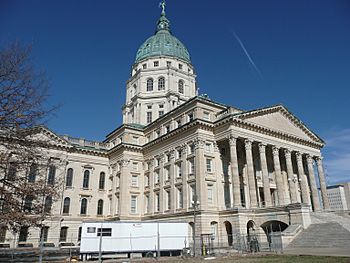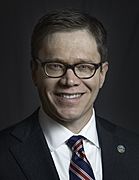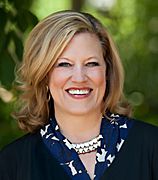Government of Kansas facts for kids
The government of the U.S. state of Kansas works like a republican democracy, similar to the U.S. federal government. It was set up by the Kansas Constitution. The state government has three main parts: the executive, the legislative, and the judicial branches. These branches use a system called "checks and balances." This means each branch has its own power, but also can limit the power of the other two. This helps keep everything fair and balanced.
The main offices for the state government are in Topeka, Kansas.
Contents
How Kansas Government Works
The government of Kansas is split into three main parts. These are the executive, the legislative, and the judicial branches.
The Governor is the state's top leader. They manage the executive branch. But they share some power with other elected officials across the state. The Lieutenant Governor is next in line if the governor cannot do their job.
The Legislature makes the state's laws. It has two parts: the House of Representatives and the Senate. The Legislature also votes on the state's budget. It can check the executive branch through its power to oversee and even remove officials. The President of the Kansas Senate leads the Senate. The Speaker of the House leads the House. Both can become governor if a vacancy happens after the lieutenant governor.
The judicial branch is independent. It uses a legal system based on old British laws. It has two top courts: the Supreme Court for civil cases (about people's rights) and the Court of Appeals for criminal cases (about breaking laws). There is also a special court that watches over all elected officials, including Supreme Court justices.
People in Kansas can also get involved directly in their government. They can vote on laws (referendum), remove officials (recall), and approve changes to the constitution (ratification).
Kansas's Constitution
The Wyandotte Constitution is the main rulebook for Kansas. People voted to approve it on October 4, 1859. In April 1860, the U.S. House of Representatives voted to let Kansas join the United States under this constitution. However, senators from states that allowed slavery tried to stop it.
As the Civil War began and slave-holding states left the Union, these senators also left their seats. On January 21, 1861, the remaining senators passed the bill. President James Buchanan signed it on January 29, 1861. This officially made Kansas a free state.
Executive Branch
The executive branch of Kansas government is led by the Governor of Kansas. The governor gets help from Cabinet Secretaries. These secretaries are chosen by the governor and approved by the Kansas Senate. The Lieutenant Governor of Kansas is next in line to become governor if the position becomes empty. The governor decides what the lieutenant governor will do.
Elected Officials
- Elected Executive Officials in Kansas
-
Laura Kelly (D)
Governor -
Kris Kobach (R)
Attorney General -
Scott Schwab (R)
Secretary of State -
Steven Johnson (R)
State Treasurer -
Vicki Schmidt (R)
Insurance Commissioner
The Governor of Kansas
The governor is both the head of state and head of government for Kansas. The constitution says the governor is elected for a four-year term. The governor leads the executive branch and is in charge of the state's military (militia). They make sure state laws are followed and that peace is kept.
The governor is also Kansas's main representative. They speak for the state to other states, the U.S. federal government, and other countries. The governor must sign all bills passed by the legislature for them to become law. If the governor says "no" to a bill (this is called a veto), the legislature can still make it a law. They need a two-thirds vote to do this.
Usually, the governor cannot make laws on their own. But if the legislature allows it, the governor can issue executive orders. These orders apply across the state. However, they are not laws and must be directly related to the governor's duties. If the governor's political party controls the legislature, the governor can suggest new laws. They can also ask other executive officers to take certain actions. In emergencies, the governor can get special, wide-ranging powers. These powers include more control over state and local agencies.
To become governor, a candidate must get the most votes in the election. In Kansas, usually one of two main parties, the Democrats or the Republicans, wins. If two or more candidates get the same number of votes, the legislature chooses the governor.
The state constitution calls the governor the state's chief leader. This means the governor is the most important person in Kansas politics. Even though the governor shares power with other officials, they choose who fills empty spots in the executive branch. The governor also appoints the leaders of most state departments and agencies. They also choose members of most state commissions and boards. These choices need approval from the Senate. Some appointees serve as long as the governor wants, while others have set terms.
The Lieutenant Governor
The lieutenant governor is the second-highest official in Kansas. They are the first person to take over as governor if the position becomes empty. The lieutenant governor is elected for a four-year term, at the same time as the governor. If the governor is away from the state or cannot do their job, the lieutenant governor takes on all the governor's powers and duties.
Legislative Branch

The Kansas Legislature is the state's law-making branch. It has two parts: the Senate and the House of Representatives. All of the state's power to make laws belongs to the legislature. Its most important powers include collecting taxes, borrowing money, and keeping the state's military (militia) ready. The constitution gives the legislature the power to make laws on all proper topics.
The legislature usually meets once a year. Meetings start in January and typically last about 90 days. The governor can call special meetings if needed. The governor has a big say in what the legislature works on. All laws made by the legislature must be approved by a majority in both houses. Then, the governor must sign them to make them official. But if the governor says "no" (vetoes) a bill, the legislature can still pass it. They need a two-thirds vote in both houses to override the governor's veto. For bills about money (appropriations bills), the governor can veto specific parts of the bill.
The Senate
The Senate is the "upper house" of the legislature. It has 40 seats, with one senator from each of the state's 40 districts. State Senators serve four-year terms. About half of the Senate seats are up for election every two years. The lieutenant governor does not lead the Senate. Instead, the Senate chooses its own President. This President also has legislative duties and is third in line to become governor.
The House of Representatives
The House of Representatives is the "lower house" of the legislature. It has 125 seats. The number of representatives from each county depends on its population. Each member serves for a two-year term. All House seats are up for election every two years. The leader of the House is the Speaker of the Kansas House of Representatives. The Speaker is fourth in line to become governor, after the lieutenant governor and the Senate President.
Any bills about raising money must start in the House of Representatives. However, the Senate can change or add to these bills as they see fit.
Judicial Branch
The judicial system of Kansas is the part of the government that explains the state's laws and constitution. It is led by the Kansas Supreme Court. The judiciary includes two top courts, general courts, and specialized courts. There are also two independent courts in Kansas.
When judges and justices need to be appointed, the governor makes the choice. First, the Kansas Judicial Nominating Commission suggests three candidates. The governor then picks one of these candidates for the job.
The Supreme Court
The Supreme Court has a chief justice and seven other justices. The governor appoints them from a list of three judges given by the Judicial Nomination Commission. Voters then confirm these justices in the next general election. They are also confirmed at the end of each six-year term. Justices serve until they quit or voters decide not to keep them. The Supreme Court's decisions must be followed by all lower state courts.
The court has the power to hear certain cases first. It also oversees all lower courts, agencies, and boards that use power under the constitution. The court can review decisions from anywhere in the state for most cases. However, for criminal cases, the Court of Criminal Appeals has the final say. If there is ever a question about which court should hear a case, the Supreme Court decides, and its decision is final.
The Supreme Court is located in the Kansas Judicial Center in Topeka, Kansas. It hears arguments from lawyers every year.
The Supreme Court also oversees the lower courts through the Administrative Office of the Courts. It also supervises lawyers in Kansas through the Kansas Bar Association. All decisions about allowing lawyers to practice or removing them are made based on the association's advice. The Supreme Court usually approves these decisions. The association has about 6,900 members, including lawyers, judges, law students, and paralegals.
At least four of the seven justices must agree to confirm, change, or overturn a lower court's decision. Once the court decides, one justice writes the court's official opinion. Once this opinion is published, it becomes the main rule for similar legal issues in the state. This is called stare decisis.
The Kansas Constitution says that the justice who has served the longest on the Court becomes the chief justice. This happens unless that justice declines or resigns. The Chief Justice of Kansas is in charge of running all courts in the Kansas Judiciary. They also set rules for all courts to follow. The Chief Justice also oversees all practicing lawyers in the state.
County Government
A county is a main administrative area in Kansas. There are 105 counties in the state. Counties include many towns and cities, as well as all land that is not part of a city. Every county has a county seat. This is often a busy or central city or town where the county government is located.
Counties in Kansas have a moderate amount of power. They act as extensions of the state government. Counties mainly handle administrative tasks. They have executive and some judicial powers, but they do not make laws. Their main jobs are to manage and plan for all the land within their borders that is not part of a city. This includes overall planning, police services, and some legal services.
Counties keep records of important events like births, deaths, marriages, and divorces. They also record property ownership and court activities. Counties must also maintain a court system, law enforcement, roads, bridges, and voter registration.
As extensions of the state government, counties are responsible for six main services:
- Keeping peace and protecting people and property.
- Collecting taxes to run the county.
- Keeping public records that are important for property rights.
- Building and taking care of public roads, highways, and bridges.
- Providing places for courts and managing justice through the District Court system.
- Helping the needy, children without parents, and the elderly.
Each county government has eight elected officials and a district attorney. All county officials serve four-year terms. Their terms start on the first Monday in January after they are elected.
See also







